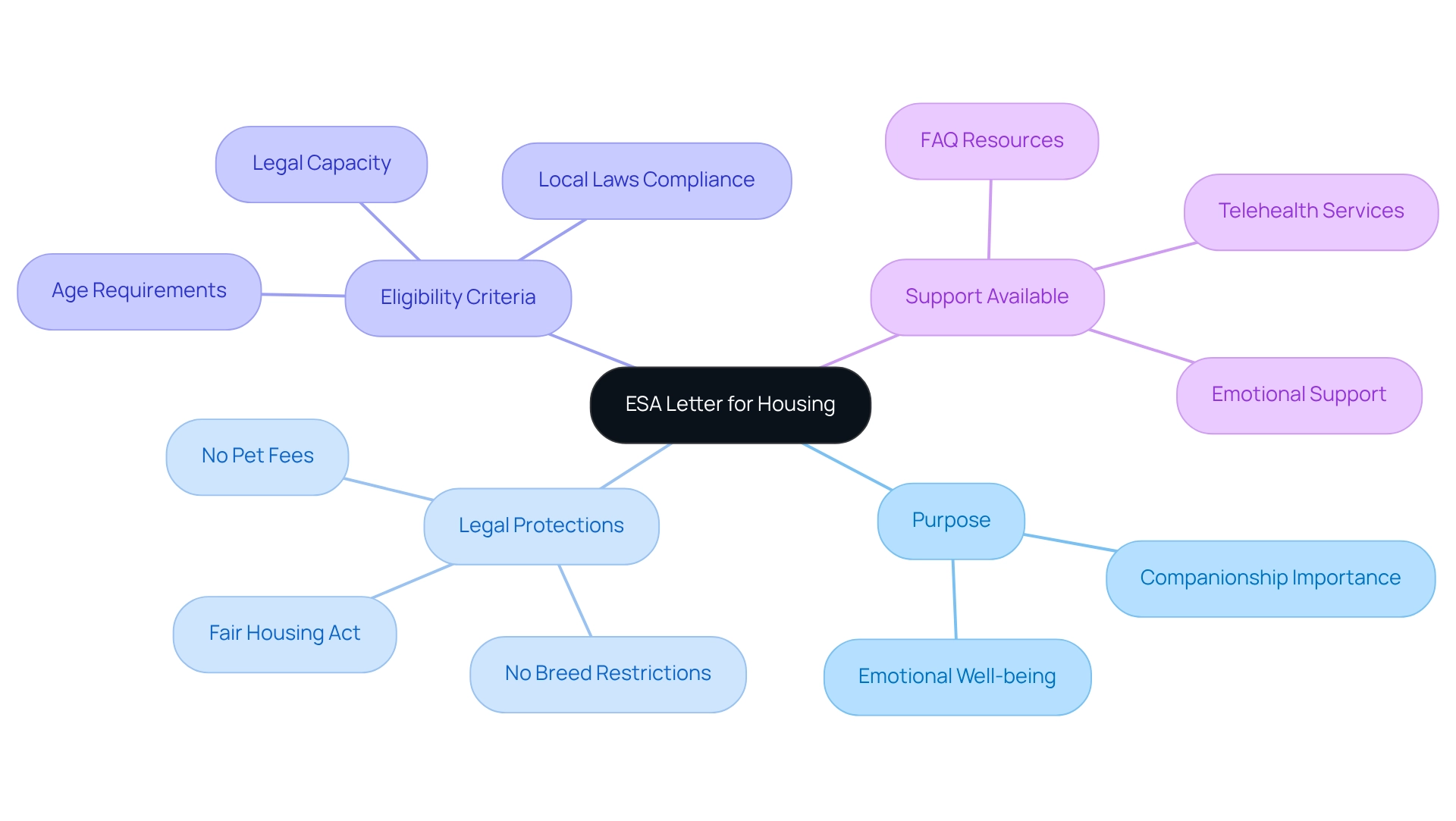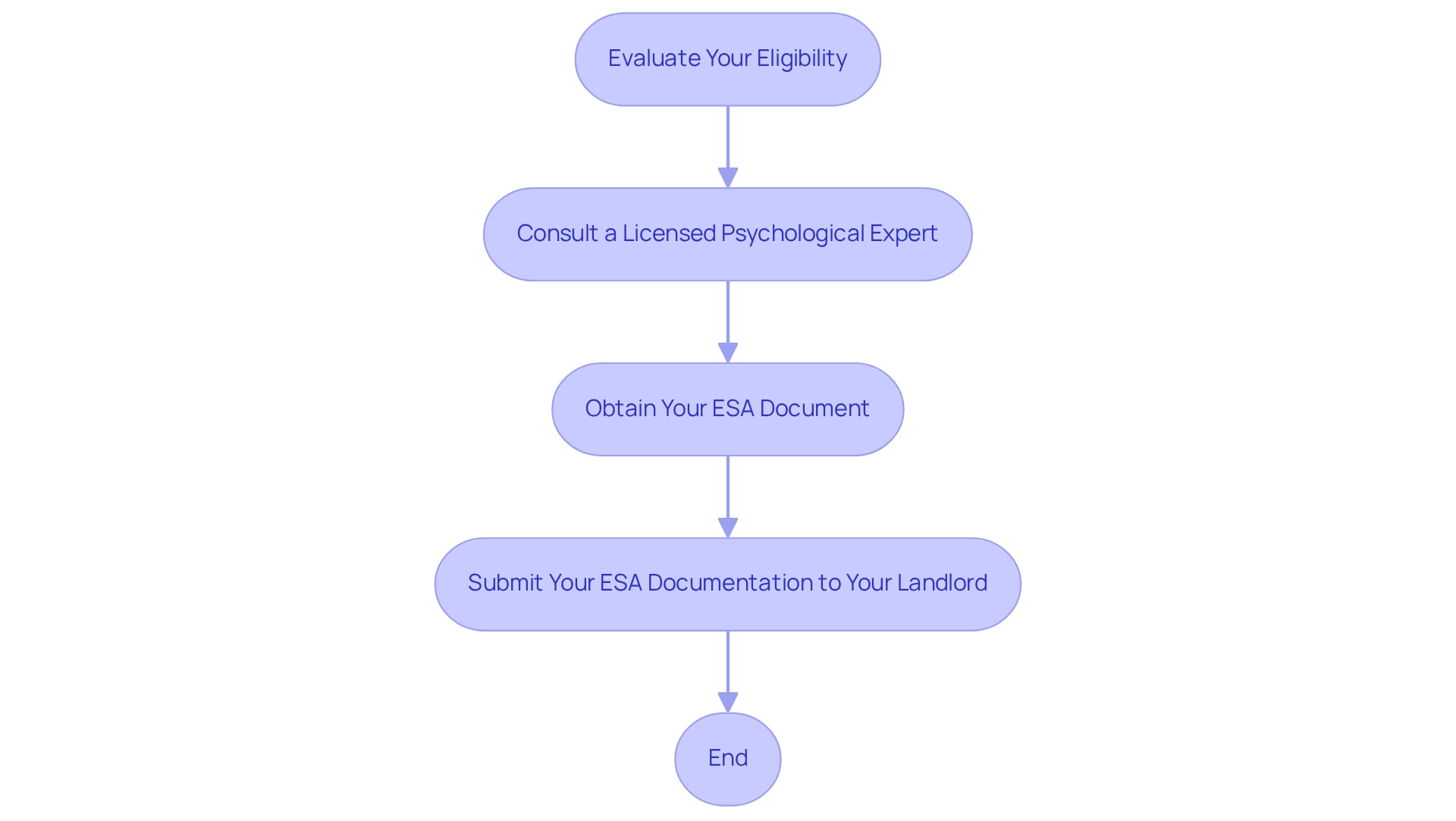

3 Steps to Get Your Free ESA Letter for Housing
by Lena Park
Last updated: June 6, 2025
Verified and Approved by:
Angela Morris,
MSW, LCSW
Fact Checked

Overview
Navigating the path to obtaining a free ESA letter for housing can be challenging for individuals facing mental health issues. It’s essential to first evaluate your eligibility and consult with a licensed mental health professional. This step is crucial, as it ensures that you receive the proper support you need. Once you have the necessary documentation, submitting it to your landlord can feel daunting. However, it’s important to have a legitimate ESA letter that aligns with the Fair Housing Act, as this protects your rights and helps you avoid common pitfalls in the process.
The emotional weight of seeking support can feel overwhelming at times. Many individuals grapple with feelings of uncertainty and worry about whether they will be understood or accepted. This is where the ESA letter becomes a beacon of hope. It not only validates your needs but also opens the door to a supportive living environment where you can thrive.
Remember, you are not alone in this journey. There are compassionate professionals ready to assist you in obtaining your ESA letter, ensuring that you have the legal protection you deserve. Take a moment to reflect on your experiences—how would having an ESA change your life? Embracing this support can lead to a more fulfilling and peaceful existence. You deserve a space where you feel safe and supported, and an ESA can provide that comfort.
Introduction
Navigating the complexities of housing regulations can be overwhelming, particularly for those who rely on the companionship of an emotional support animal (ESA). An ESA letter is not merely a document; it is a crucial resource that enables tenants to live alongside their support animals, even in pet-restricted environments.
Understanding the significance and the process of obtaining this letter is essential for individuals seeking comfort and companionship during difficult times. The journey to securing an ESA letter requires careful thought and informed steps, from assessing eligibility to steering clear of common pitfalls. This process can ultimately lead to a more fulfilling living experience, providing the emotional support that many need.
Understand the Purpose of an ESA Letter for Housing
An Emotional Support Animal (ESA) certificate serves as a compassionate lifeline for individuals facing mental health challenges. This formal document, issued by a licensed mental health professional, confirms that companionship with an animal is essential for one’s emotional well-being. For those living in pet-restricted housing, securing a free esa letter for housing is crucial, as it grants the right to keep their emotional support animal despite any no-pet regulations. Under the Fair Housing Act, landlords are required to provide reasonable accommodations for tenants with ESAs by offering a free esa letter for housing, which means they cannot impose pet fees or breed restrictions.
Understanding the significance of this document is the first step toward ensuring you can live harmoniously with your emotional support animal, free from discrimination or additional costs. At Wellness Wag, we are dedicated to simplifying the online process of obtaining valid ESA documents through our telehealth services. Our goal is to empower individuals to navigate this journey with confidence and compassion.
To qualify for an ESA document, individuals must meet specific eligibility criteria, including age, legal capacity, and adherence to local laws. If you have questions about ESA letters, we invite you to explore our FAQ section, where you can find more information. Remember, you are not alone in this journey; support is available, and we are here to help you every step of the way.

Follow the Steps to Obtain Your ESA Letter
-
Evaluate Your Eligibility: Begin by reflecting on whether you have a qualifying psychological condition, such as anxiety, depression, or PTSD. Consider how an emotional support animal can help you manage your symptoms. Remember, an Emotional Support Animal offers comfort and alleviates the challenges associated with your condition, promoting your overall well-being.
-
Consult a Licensed Psychological Expert: Schedule a meeting with a certified therapist or psychiatrist who can assess your psychological needs. Be open about your experiences and express your desire for an ESA. This professional will help determine if an ESA is the right fit for you. At Wellness Wag, we are here to streamline this process by connecting you with a licensed medical professional for a personalized consultation.
-
Obtain Your ESA Document: If approved, the mental health professional will provide you with an ESA document. Ensure that it contains their licensing information, signature, and contact details. This document should be on official letterhead and clearly state your need for a free esa letter for housing to support your emotional support animal.
-
Submit Your ESA Documentation to Your Landlord: Once you have your document, kindly present it to your landlord or housing provider. Familiarize yourself with your rights under the Fair Housing Act to ensure that you are treated fairly and can obtain a free esa letter for housing.
To get started, take our quick assessment at Wellness Wag to share your situation and emotional support needs, allowing us to tailor our services to your journey with an emotional support animal.

Avoid Common Pitfalls When Securing Your ESA Letter
-
Steer clear of internet fraud: It’s important to be cautious of websites that offer a free esa letter for housing without a thorough evaluation by a certified psychological expert. Valid correspondence should always come from a certified professional who truly understands your unique psychological needs.
-
Ensure your document is specific: Your free esa letter for housing needs to clearly articulate your mental health condition and the necessity of having an emotional support animal. Vague messages may not be accepted by property owners, which can add to your stress during an already challenging time.
-
Keep Documentation Current: Some landlords might request updated ESA documents during lease renewals. It’s essential to ensure that your correspondence is current and accurately reflects your ongoing need for an emotional support animal, as this can ease potential worries.
-
Communicate Openly with Your Landlord: When you present your ESA letter, be ready to discuss your rights under the Fair Housing Act. Open and clear communication can help prevent misunderstandings and foster a more supportive environment for your request.

Conclusion
Navigating the process of obtaining an Emotional Support Animal (ESA) letter can be a vital step for individuals seeking companionship and comfort in their living situations. Many face emotional challenges that can feel overwhelming, and understanding the purpose of an ESA letter is crucial. This letter not only provides legal protection under the Fair Housing Act but also ensures that individuals can live with their emotional support animals without facing discrimination or additional costs.
By following the outlined steps—assessing eligibility, consulting with a licensed mental health professional, receiving the letter, and presenting it to landlords—you can streamline your journey. It’s important to approach this process thoughtfully, as common pitfalls like online scams or vague documentation can create unnecessary stress. Keeping communication open with landlords and ensuring that the ESA letter is specific and up-to-date will further safeguard your rights and promote a smoother experience.
Ultimately, securing an ESA letter can significantly enhance the quality of life for those who rely on the emotional support of their animals. By taking informed steps and understanding the legal framework, you can create a fulfilling living environment that nurtures your mental well-being and fosters the companionship you need. Remember, you are not alone in this journey; support is available, and your emotional health matters.
Frequently Asked Questions
What is the purpose of an ESA letter for housing?
An ESA letter serves as a formal document confirming that companionship with an animal is essential for an individual’s emotional well-being, particularly for those facing mental health challenges. It allows individuals to keep their emotional support animal in pet-restricted housing.
Who issues ESA letters?
ESA letters are issued by licensed mental health professionals.
What rights do individuals have under the Fair Housing Act regarding ESAs?
Under the Fair Housing Act, landlords are required to provide reasonable accommodations for tenants with ESAs, which includes allowing them to keep their emotional support animal despite no-pet regulations, and they cannot impose pet fees or breed restrictions.
How can individuals obtain an ESA letter?
Individuals can obtain a valid ESA letter through telehealth services, which simplifies the online process of acquiring the necessary documentation.
What are the eligibility criteria for obtaining an ESA document?
To qualify for an ESA document, individuals must meet specific criteria, including age, legal capacity, and adherence to local laws.
Where can individuals find more information about ESA letters?
Individuals can explore the FAQ section provided by organizations like Wellness Wag to find more information about ESA letters and the process involved.
Certify Your Emotional Support Animal Today

Why You Can Rely on Us?
At Wellness Wag, we believe your pet deserves care rooted in both science and compassion. Each article is carefully researched, written in clear language for pet owners, and then reviewed by qualified professionals to ensure the information is evidence-based, current, and practical for real-life care. Our goal is to help you feel confident in making informed decisions about your pet’s health and well-being.
Reviewed by
Angela Morris, MSW, LCSW
Angela is a licensed clinical social worker with 20 years of experience in patient advocacy and community mental health. She has assisted numerous clients with ESA evaluations and brings a deep understanding of disability accommodations, ensuring that all information is accurate, supportive, and practical.

Written by :
Lena Park
Last Updated :
June 6, 2025












